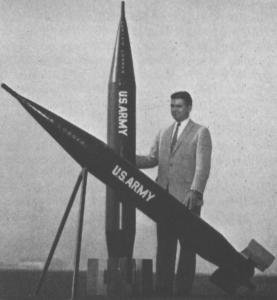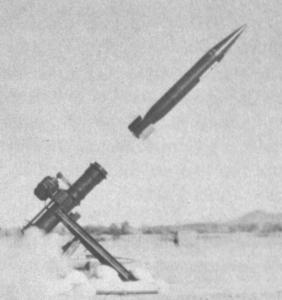Convair Lobber
In 1958, Convair developed a short-range cargo-carrying surface-to-surface rocket for the U.S. Army. The rocket, called Lobber, was to be used to provide forward troops with needed supplies in case ground-based support lines are disrupted. It was first flight-tested in December 1958.
Lobber was powered by a solid-fueled rocket motor and was launched from a simple portable launcher. One rocket and launcher could be hand-carried by a three man team. The nose cone, which could carry up to 23 kg (50 lb) of cargo, was a quick-disconnect type for easy configuring and loading. To prevent damage to its cargo, the Lobber used a parachute and a shock-absorbing nose cone. The rocket had a maximum range of about 13 km (8 miles).
 |
 | |
| Photo: Convair | Photo: via Ordway/Wakeford | |
| Lobber | ||
Although the flight tests were apparently basically successful, and Convair also proposed alternate nose cones with various military warheads (including high-explosive, napalm, chemical and nuclear ones), the Lobber was not developed further. It appears that the utility of a troop supply rocket was not regarded high enough to warrant the development and fielding of yet another artillery rocket.
Specifications
Note: Data given by several sources show slight variations. Figures given below may therefore be inaccurate!
Data for Lobber:
| Length | 2.7 m (9 ft) |
| Diameter | 25 cm (10 in) |
| Speed | 2400 km/h (1500 mph) |
| Range | 13 km (8 miles) |
| Propulsion | Solid-fueled rocket |
Main Sources
[1] John W. R. Taylor (ed.): "Jane's All the World's Aircraft 1960-61", Jane's, 1961
[2] Frederick I. Ordway III, Ronald C. Wakeford: "International Missile and Spacecraft Guide", McGraw-Hill, 1960
[3] Norman J. Bowman: "The Handbook of Rockets and Guided Missiles", Perastadion Press, 1963
Back to Directory of U.S. Military Rockets and Missiles, Appendix 4
Last Updated: 13 June 2003